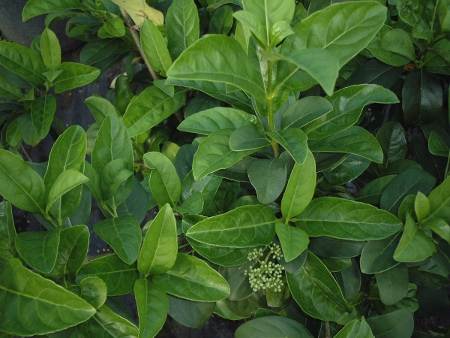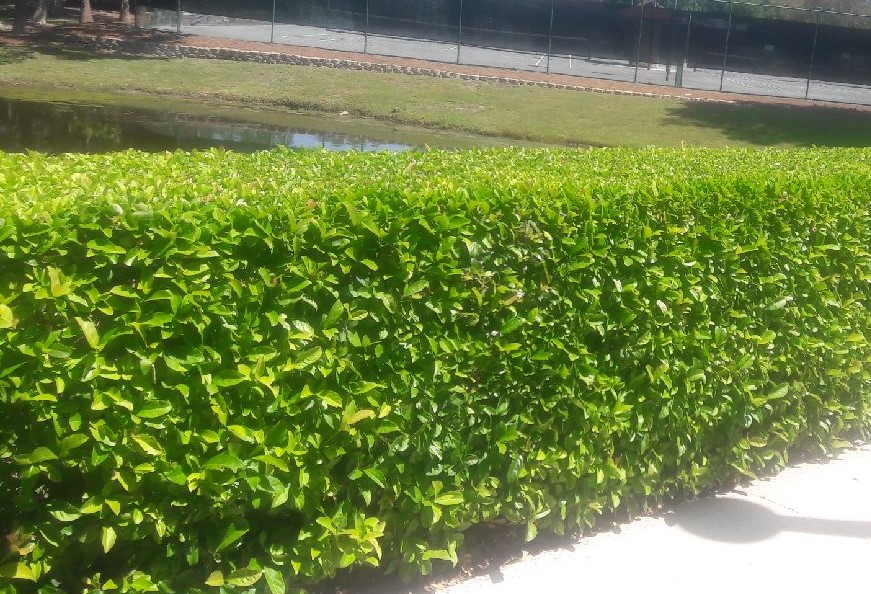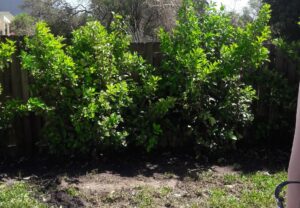S & J Nursery’s Guide to Growing Sweet Viburnum For Northeast Florida Landscapes
( Viburnum Odoratissimum )
– Viburnum odoratissimum is native from the Himalayas to Japan but has been evaluated by UFIFAS and found to be Florida friendly.

Sweet Viburnum Preferred Exposure:
– Viburnum will tolerate full sun to shade situations in the North Florida |
Jacksonville | St. Augustine areas gardens.
Sweet Viburnum Foliage:
-Large evergreen foliage makes Viburnum Odoratissimum a showy landscape accent any time of the year. Its large leaves emerge bright green and mature to a nice medium green color, expect them to be just a larger as well as a bit darker when planted in a shaded situation in the North Florida
landscape.
Sweet Viburnum Soil Preference / Salt tolerance:
– Viburnum Odoratissimum will prefer well drained soils but is not particular about the makeup or content of that soil. It tolerates clay, sand, loam acidic or alkaline conditions equally well.
– Not recommended for use in poorly drained areas that will stay wet during our heavy rain season. If you just must plant Viburnum into a moist area raise it 3-6 inches above the existing soil level to help its roots get up out of the water after a rain.

– Sweet Viburnum has a low salt tolerance and should be avoided on coastal
properties.
Sweet Viburnum Size Variance:
– Although classified as a shrub Viburnum Odoratissimum can reach sizes of 15-25+ feet H | 15+ feet W depending on how many trunks are allowed to develop.
Sweet Viburnum Growth Habit:
– Viburnum shrubs will need clipped and shaped to keep it as a squared
hedge for privacy screens and foundation planting, but when lower branches are removed and it is allowed to grow as a tree a nice round head will develop without our help.
Sweet Viburnum Growth Rate:
– Fast growing shrub quickly establishes itself into the landscape.

Sweet Viburnum Bloom:
– Large very fragrant, clusters of attractive white flowers cover the plant
each spring followed by small red berries that mature to a deep black are are moderately showy in summer.
Sweet Viburnum Water Requirements:
– Viburnum odoratissimum is drought tolerant once established nto the
landscape. Good choice for low water areas as they will continue to grow well once supplemental irrigation is reduced.
Butterfly or Bird Attracting:
– n/a
Best Uses For Sweet Viburnum:
– Viburnum odoratissimum is a great choice for a fast growing shrub or small tree. Use them as the backdrop to the perennial border or as a hedge screen that is just perfect for a quick privacy fence. Excellent choice for a small landscape specimen tree as its root system is not invasive it can be planted close to the foundation of a home or sidewalk etc. with no damage. Also a good choice for a shade tree where overhead power lines restrict the use of larger growing selections.
– Sweet Viburnum may not be the best choice for hedges that need to be
kept under 4 ft unless you just love pruning your hedges. These fast growing plants flush new growth almost immediately after a pruning so if attempting to keep them as a foundation plant remember to prune down 6 inches beneath where you would like to see their growth be to give yourself some time before the next pruning is needed.
Care of S & J Nurserys North Florida | Jacksonville | St. Augustine Shrubs:
– Shrubs can be planted in the North Florida | Jacksonville | St. Augustine
area at any time during the year. In normal and well draining soils dig the hole as deep as the root ball and two to three times as wide. Plant the top of the root ball level or slightly higher than the surrounding soils. When planting in poorly drained soils make sure to plant your shrubs into a raised mound a minimum of 3 inches ABOVE the surrounding soil level.
– Water every day during the establishment period. For most 3 gallon size
shrubs in the North Florida landscape in average soil, that is neither heavy clay that holds water or really sandy that will take 2-3 weeks of daily watering to ensure that your newly planted shrub will begin to put out new roots and grow into its new home happily. After the first few weeks begin
tapering back your watering to every other day then every third day and so on until your newly planted items are flourishing without your assistance.

– If planting larger shrubs you may need to extend the initial care a bit
longer to protect your investment and get your shrubs off to the best start possible.
– IMPORTANT: If planting shrubs in heavy clay soils that hold a lot of
water after a rain or irrigating, remember to check the soil for moisture by sticking your fingers into the soil near the rootball of the newly planted shrub down to 2-3 inches. If it remains wet from the previous watering
wait for the top 2-3 inches to dry out before watering again.
– IMPORTANT: When planting shrubs into poor sandy soils be sure to amend the planting hole by mixing compost or cow manure etc. with the native soil that will go back in the hole around the new plants root ball when installing your shrub material, this will not only give your new shrubs good soil to grow its new roots into but help it hold water.
– When planting shrubs from containers be sure to loosen the roots as much as possible pulling loose roots away from the root ball before installing your new plants, if the roots are to tight to easily loosen with your hands use a knife to cut a few slits into the root ball being careful to go all the way from the top to the bottom and making the cut at least an inch deep. This will ensure that your plant will immediately begin to form new roots into its new surrounding soil.
– Mulch newly planted shrubs whenever possible.
– Fertilize each spring with a shovel full of good garden compost or a mixture of Milorganite and a Slow release poly coated plant food such as Osmocote or Stay Green general purpose plant food, sprinkling the fertilizer around the mulch circle underneath the foliage of the tree.
– Prune as needed to shape each spring and or summer.

